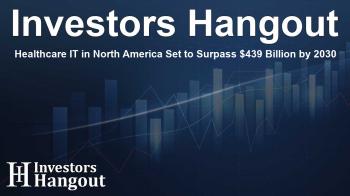Healthcare IT in North America Set to Surpass $439 Billion by 2030

Rapid Growth of the North American Healthcare IT Market
The North American healthcare IT market is experiencing significant growth, driven by advances in technology and a growing emphasis on digital health solutions. Valued at approximately US$202.12 billion in 2024, the market is set to gain momentum, with expectations of reaching US$229.05 billion the following year. Analysts project this market will continue to expand, culminating in an impressive valuation of US$439.09 billion by the end of the decade, representing a compound annual growth rate (CAGR) of 13.9% from 2025 to 2030.
Factors Fueling Market Expansion
The surge in the healthcare IT market can be attributed to several key factors, including heightened awareness of digital health’s benefits, government initiatives, and financial incentives designed to encourage the adoption of healthcare IT solutions. Additionally, the increasing use of big data and the high returns on investments related to IT solutions are propelling demand. As chronic diseases become more prevalent, the pressure on healthcare providers to leverage technology to improve patient outcomes intensifies.
Shifts Towards Value-Based Care
A notable trend in the industry is the shift toward value-based care, which emphasizes patient outcomes rather than the volume of services provided. This change incentivizes healthcare providers to adopt advanced healthcare information technology (HCIT) solutions that improve safety and quality of care. With initiatives aimed at integrating technology into everyday healthcare practices, this market is expected to grow substantially as providers look for innovative ways to enhance patient engagement and operational efficiency.
Market Segmentation and Trends
The North American healthcare IT market is broadly categorized into three components: hardware, software, and services. Among these components, the services segment is projected to hold the largest share due to the robust technological infrastructure supporting healthcare systems. Providers increasingly depend on IT services for implementation, integration, maintenance, and support. This reliance is fueled by stringent regulatory frameworks that require ongoing compliance and expertise.
Clinical HCIT Solutions on the Rise
Within the varying types of healthcare IT solutions, the clinical HCIT solutions segment is witnessing the fastest growth within the provider solutions market. As the need for improved patient safety and quality of care rises, propelled by government regulations, this segment has gained traction. Moreover, the integration of advanced technologies such as artificial intelligence and data analytics significantly supports healthcare providers in managing patient care more effectively.
Geographical Insights and Market Leaders
In 2024, the United States was at the forefront of the North American healthcare IT market, driven by its robust healthcare infrastructure, widespread digital health awareness, and rapid adoption of cutting-edge technologies. The presence of prominent healthcare IT companies strengthens this market's position. Government backing, including financial incentives and public health initiatives, further enhances adoption rates of healthcare IT solutions. Additionally, the growing prevalence of chronic diseases among a tech-savvy population propels the country’s market dominance.
Prominent Players in the Market
The North American healthcare IT market features several prominent players, including Oracle, Veradigm, McKesson, and Optum, among others. These companies adopt various strategies, including acquisitions and product launches, to expand their influence within the sector. Each organization is focused on optimizing their services to meet the evolving demands of healthcare providers.
Continued Investment in Technology
Companies like Oracle and Optum illustrate the significant investments being made in healthcare IT. Oracle focuses on providing comprehensive cloud services, while Optum invests billions annually to enhance technology offerings tailored to healthcare needs. These gaming dynamics are crucial for the future shape of healthcare IT as organizations aim to innovate and provide top-tier services.
Frequently Asked Questions
What are the expected market values for North American Healthcare IT by 2030?
The market is projected to reach a valuation of approximately US$439.09 billion by 2030.
What key factors are driving this market's growth?
Major drivers include increased demand for digital health solutions, government incentives, and significant technological advancements.
Which segment of the market is currently the largest?
The services segment holds the largest share due to the demand for a robust technological infrastructure.
Who are the key players in the North American Healthcare IT market?
Key players include major companies like Oracle, Optum, and McKesson, focusing on various strategies to enhance their market presence.
What trends are shaping the future of Healthcare IT?
The trend towards value-based care models and the rising use of AI and big data analytics are key trends shaping the future landscape.
About The Author
Contact Owen Jenkins privately here. Or send an email with ATTN: Owen Jenkins as the subject to contact@investorshangout.com.
About Investors Hangout
Investors Hangout is a leading online stock forum for financial discussion and learning, offering a wide range of free tools and resources. It draws in traders of all levels, who exchange market knowledge, investigate trading tactics, and keep an eye on industry developments in real time. Featuring financial articles, stock message boards, quotes, charts, company profiles, and live news updates. Through cooperative learning and a wealth of informational resources, it helps users from novices creating their first portfolios to experts honing their techniques. Join Investors Hangout today: https://investorshangout.com/
The content of this article is based on factual, publicly available information and does not represent legal, financial, or investment advice. Investors Hangout does not offer financial advice, and the author is not a licensed financial advisor. Consult a qualified advisor before making any financial or investment decisions based on this article. This article should not be considered advice to purchase, sell, or hold any securities or other investments. If any of the material provided here is inaccurate, please contact us for corrections.

